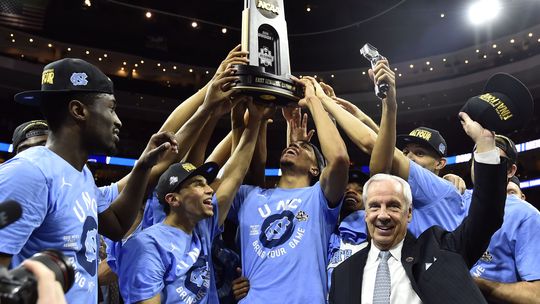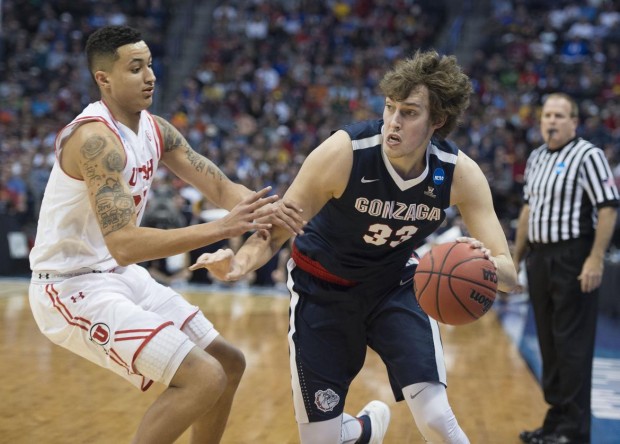The North Carolina Tar Heels won the East Region, offering the least surprising final outcome of any of the four regions.
Oklahoma would likely occupy second place among the four regional champions in terms of meeting the bracket expectations of most fans and pundits, but Carolina clearly rates first. Indiana had no answer for UNC’s size, and we saw how limited Kentucky was as a team this season. West Virginia or Xavier could have put up a fight, but only one of those two teams was going to play the Tar Heels in the Elite Eight… if one of them could get there.
In many ways, what happened in the bottom half of the East bracket represented not only the larger story of the region, but the larger story of the college basketball season. This region, more than the other three, epitomized the unstable nature of the season, even though its final outcome was the most predictable one of all.

Mar 18, 2016; Brooklyn, NY, USA; Stephen F. Austin Lumberjacks forward Thomas Walkup drives to the basket against West Virginia Mountaineers players Elijah Macon (45) , Esa Ahmad (23) and Jonathan Holton (1) in the first half in the first round of the 2016 NCAA Tournament at Barclays Center. Mandatory Credit: Robert Deutsch-USA TODAY Sports
The best player in college basketball in 2016 is Buddy Hield. That seems clear after two weeks of NCAA tournament play. Buddy is the centerpiece player of the 2016 Final Four, while Jim Boeheim will become the centerpiece coach after his remarkable run with Syracuse. Yet, if Hield is the best player in the sport, no other player enjoyed more of a national breakout in March than Thomas Walkup of Stephen F. Austin. The Lumberjacks, and the chain reactions they unleashed in the bracket, stood at the heart of the chaos which marked the bottom half of the East Region, the 6-11/3-14/7-10/2-15 subregional ultimately won by Notre Dame.
Why consider the East as more representative of college basketball 2016 than the Midwest?
First, if Virginia had held on versus Syracuse, the Midwest’s end result would have been relatively ordinary in a larger context. What happened in Cavs-Cuse was a shocking eight-minute meltdown by the 1 seed in the Midwest.
An even better argument is this: Syracuse enjoyed an easy first weekend in which everything went right, followed by an extraordinary second weekend in which it rescued itself twice. Notre Dame — whose fate was tied not only to Stephen F. Austin, but to the things SFA did to change the East bracket — played four games (maybe three and a half) on the razor’s edge, whereas Syracuse played only two.
The East’s bottom half, in other words, was more consistently unsettled and volatile than the Midwest’s bottom half, which also exploded into a whirl of disruption and disorder.
Unconvinced? You might be, and with good reason.
I’ll press the case on a few fronts.
A) Whereas Middle Tennessee faded in round two, Stephen F. Austin did not. This is a big part of why the Lumberjacks are such an important team to appreciate within the larger workings of the NCAA tournament. Had they denied Notre Dame a last-second tip-in, they’re in the Sweet 16, and they very likely would have fought Wisconsin tooth and nail for the Elite Eight berth Notre Dame ultimately won.
B) Whereas Utah was unmasked along with the Pac-12 as an oversold conference with teams which did not adequately prepare Oregon for its Elite Eight game against Oklahoma, West Virginia was a Big 12 team whose loss as a 3 seed was much more confounding… and had a much bigger impact on the whole of the East bracket.
The Oklahoma romp over Oregon drew a clear line of demarcation between the Big 12 and the Pac-12. While Michigan State’s loss to Middle Tennessee was clearly the upset of the tournament, the other upsets in the East exceeded the upsets in the Midwest… and of course, Gonzaga over Utah wasn’t even an upset according to the betting line. The divisions exposed between the Big 12 and Pac-12 made West Virginia’s exit far more of a puzzler than Utah’s loss.
Consider — as we continue to keep in mind the centrality of Stephen F. Austin in the East Region — how different this bracket becomes if West Virginia plays Notre Dame. The size and length North Carolina used on the glass against the Irish would have been used by the Mountaineers against the Irish. In a tournament that was going to depend more on matchups than on seeds (see Oklahoma getting the 2 but being sent West — it worked out perfectly for the Sooners), West Virginia had the perfect path to the Elite Eight and would have represented a difficult matchup for Carolina.
Stephen F. Austin didn’t knock out a national title favorite the way Middle Tennessee did, but in terms of influencing matchups through each of the first three rounds, the Lumberjacks — in their victory, and then in their narrow loss to Notre Dame — shaped more individual game outcomes than Middle Tennessee did.
*
One other point is worth making: Had Wichita State not been a First Four team, I would have been interested to see if it would have had the legs to take down Miami. If Wichita had won, the Shockers very much would have occupied the position Stephen F. Austin did. Alas, the Shockers didn’t get over the hump against Miami. Accordingly, SFA left the bigger imprint on the tournament, something Northern Iowa also failed to do as an 11 seed (against a 3) in the West Region.
The Midwest Region featured the biggest upset and the most spectacular 10-minute gack attack (from Virginia) in the tournament. In terms of unforgettable moments, the Midwest Region stood in tune with the 2016 college basketball season to an extent no other region matched.
However, in terms of four rounds of complexity, confusion, and domino-effect matchup alterations, the East — in scope and breadth — eclipsed the Midwest as the region most representative of what we saw from November through February.


